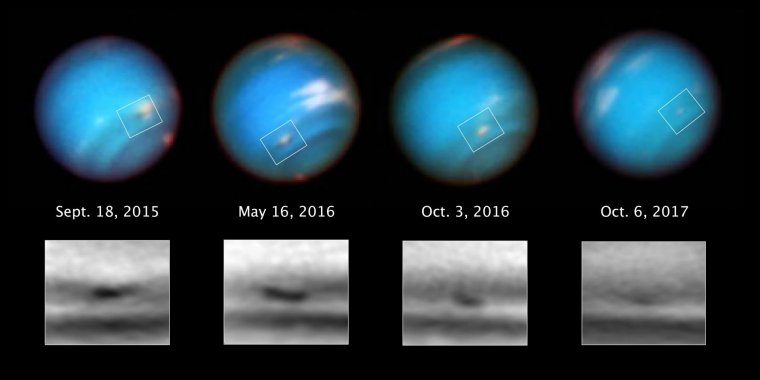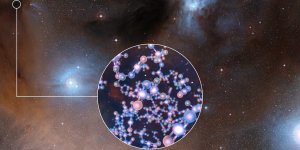| News / Space News |
Hubble Sees Neptune's Mysterious Shrinking Storm
Three billion miles away on the farthest known major planet in our solar system, an ominous, dark storm – once big enough to stretch across the Atlantic Ocean from Boston to Portugal – is shrinking out of existence as seen in pictures of Neptune taken by NASA’s Hubble Space Telescope.

This series of Hubble Space Telescope images taken over 2 years tracks the demise of a giant dark vortex on the planet Neptune. Image credits: NASA, ESA, and M.H. Wong and A.I. Hsu (UC Berkeley)
Immense dark storms on Neptune were first discovered in the late 1980s by NASA’s Voyager 2 spacecraft. Since then, only Hubble has had the sharpness in blue light to track these elusive features that have played a game of peek-a-boo over the years. Hubble found two dark storms that appeared in the mid-1990s and then vanished. This latest storm was first seen in 2015, but is now shrinking.
Like Jupiter’s Great Red Spot (GRS), the storm swirls in an anti-cyclonic direction and is dredging up material from deep inside the ice giant planet’s atmosphere. The elusive feature gives astronomers a unique opportunity to study Neptune’s deep winds, which can’t be directly measured.
The dark spot material may be hydrogen sulfide, with the pungent smell of rotten eggs.
Unlike Jupiter’s GRS, which has been visible for at least 200 years, Neptune’s dark vortices only last a few years. This is the first one that actually has been photographed as it is dying.
We have no evidence of how these vortices are formed or how fast they rotate. It is most likely that they arise from an instability in the sheared eastward and westward winds.
But the dark spot, which was first seen at mid-southern latitudes, has apparently faded away rather than going out with a bang. That may be related to the surprising direction of its measured drift: toward the south pole, instead of northward toward the equator.
Unlike Jupiter’s GRS, the Neptune spot is not as tightly constrained by numerous alternating wind jets (seen as bands in Jupiter’s atmosphere). Neptune seems to only have three broad jets: a westward one at the equator, and eastward ones around the north and south poles. The vortex should be free to change traffic lanes and cruise anywhere in between the jets. (NASA)
YOU MAY ALSO LIKE



